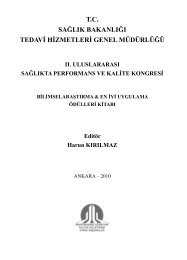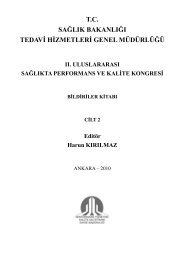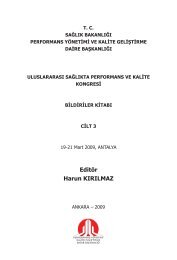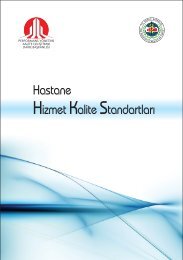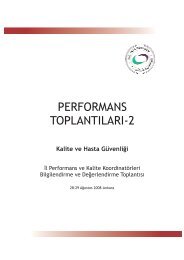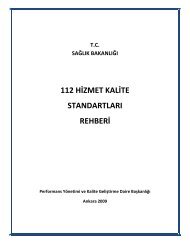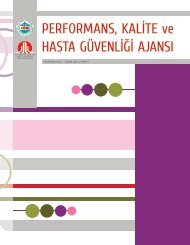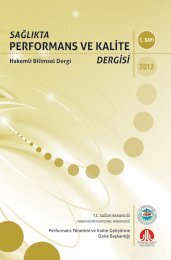PERFORMANS ve KALÄ°TE - SaÄlıkta Kalite ve Akreditasyon Daire ...
PERFORMANS ve KALÄ°TE - SaÄlıkta Kalite ve Akreditasyon Daire ...
PERFORMANS ve KALÄ°TE - SaÄlıkta Kalite ve Akreditasyon Daire ...
You also want an ePaper? Increase the reach of your titles
YUMPU automatically turns print PDFs into web optimized ePapers that Google loves.
Laboratuvar Çalışanlarında İşe Bağlı Kas İskelet Sistemi Sorunları <strong>ve</strong> Ergonomik Risklerinin Değerlendirilmesi<br />
Sonuç: Laboratuvar çalışanları işe bağlı kas-iskelet hastalıkları için orta derecede<br />
risk altındadır. Ergonomi eğitimleri <strong>ve</strong> girişimlerini kapsayan ergonomi programı<br />
uygulanmasının yararlı olacağı düşünülmektedir.<br />
Anahtar Kelimeler: Ergonomi, Ergonomik risk, Laboratuvar çalışanları<br />
Occupational Musculoskeletal System Troubles and Assessment of Ergonomic<br />
Risks in Laboratory Staff<br />
ABSTRACT<br />
Aim: To define the ergonomic risks in the Laboratories of Sandıklı State<br />
Hospital, and to re<strong>ve</strong>al the work-related musculoskeletal system problems in the<br />
laboratory staff.<br />
Importance: Occupational musculoskeletal system diseases appear due to the<br />
recurrent physical mo<strong>ve</strong>ments of workers, working in bad posture, stress, violence,<br />
uninterrupted long-time work, and unsitable ergonomic conditions.<br />
Method: This study was carried out by applying a questionnaire and an<br />
observation form on 17 laboratory workers in September and October 2010. The data<br />
were processed in Elde edile <strong>ve</strong>riler Microsoft Excell, Ergo Fellow 2.0 ergonomy risk<br />
assessment program, and SPSS 11.5. Means and standard deviations were used in the<br />
statistical analysis.<br />
Findings: The laboratory technicians consist the largest portion of the study<br />
group (41%). The pain complaning incidence in last 12 was 71 % on the dorsal<br />
area, 71 % on the shoulders, 65 % on the lumbal area, 65 % on the neck, and 59 %<br />
on the wrist. The noise (2,41 ± 0,61), changes in assignments (2,29 ± 0,58), quality of<br />
chairs and seats (2,25 ± 0,57), working stress (2,23 ± 0,56), vibration (2,11 ± 0,85),<br />
working temp (2,05 ± 1,02), and heat (2,00 ± 0,70) were defined as the prominent<br />
ergonomic risk factors in the laboratory.<br />
Conclusion: Laboratory staff are under medium le<strong>ve</strong>l risk in terms of workrelated<br />
musculoskeletal system health problems. A training program in ergonomi is<br />
considered as useful for them.<br />
Key Words : Ergonomy, Ergonomic risk, Laboratory staff<br />
GİRİŞ<br />
Günümüzde hızla gelişen teknoloji, her alanda olduğu gibi çalışma<br />
yaşamında da önemli değişimleri beraberinde getirmektedir. Bu değişimlerin<br />
bir sonucu olarak, üretim sürecinde de hızlı <strong>ve</strong> yoğun bir makineleşme<br />
yaşanmaktadır. Bu hızlı değişim, üretim sürecinde fiilen çalışan insanların<br />
yeteneklerini bedensel <strong>ve</strong> düşünsel açıdan çeşitlendirmekte <strong>ve</strong> çalışanlar<br />
SAĞLIKTA <strong>PERFORMANS</strong> VE KALİTE DERGİSİ<br />
91





